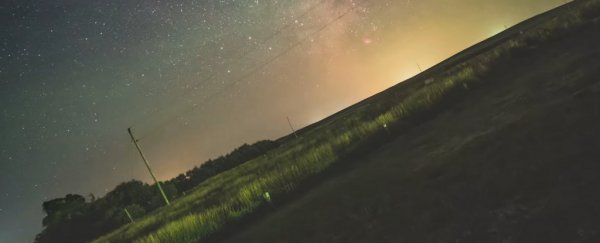From where we stand here on Earth, it's easy to forget our planet is in constant motion. Most traditional time lapses of the Milky Way make it look as though the night sky is rotating around us - but it's actually the other way around.
A dazzling video from astro-photographer Aryeh Nirenberg corrects that perspective, making the reality look incredibly lop-sided. Taking a series of images every 12 seconds for about 3 hours, the photographer was able to capture Earth's rotation in relation to the Milky Way.
The result is a steadily tilting floor that looks as though it's about to dump you off the face of the planet.

This dizzying time lapse was taken in Colorado almost two years ago, and it was never intended to turn out this way.
"I went to this area for the first time to capture a timelapse of the Milky Way with a reservoir in the foreground, but access to the side of the reservoir that was facing the Milky Way was blocked by a fence," Nirenberg told ScienceAlert.
"I decided since I couldn't have the reservoir in the foreground of my timelapse, I needed to do something else to make it interesting."
He settled on using an equatorial tracking mount, which is a common tool used in astrophotography that allows you to track stars and planets as they move across the sky. It does this by mimicking the near-constant rotation of Earth.
"I thought of the idea to put my camera on the equatorial mount and capture a timelapse of the ground moving instead of the sky," Nirenberg explained.
As our planet makes its way around the Sun, it rotates on an axis that runs from north to south, spinning at roughly 1,600 kilometres per hour (1,000 miles per hour). The time it takes to complete this rotation is called a sidereal day, which is not exactly 24 hours - it's more like 23.9344696 hours.
The mount, therefore, works by rotating at the same rate and along the same axis as our own planet, but in the opposite direction.
"Equatorial mounts are aligned to the North Star and rotate the camera at a rate of 15° per hour which is the same rate of Earth's rotation," says Nirenberg, "so the camera follows the stars in the sky, and the camera remains pointed at the same part of the sky no matter how many hours pass."
This is what allows the Milky Way to appear 'fixed' in the timelapse as our planet rotates underneath it - serving a piece of classic astrophotography with a major twist.
And with that, we can now experience a beautiful shift our perspective of the galaxy, and our own tiny place within it.
